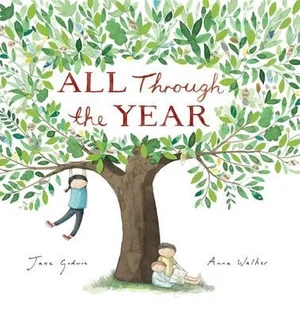Book Week: Reading in the kitchen garden

We've highlighted some of our favourite books covering the Kitchen Garden experience, especially for Book Week! These can be read for an activity on a rainy day, to provide background or consolidation for a class activity, or as suggestions for at-home or individual reading time. Members can find our more comprehensive list via the Shared Table.
Beginning a Kitchen Garden class by reading a story is a perfect way to introduce children to whatever topic the lesson will focus on. Kate Beckwith, the Foundation’s Professional Development Coordinator, notes the value of story time in the Kitchen Garden Program, saying it “offers a captivating introduction to a learning topic for early childhood or primary-aged children”.
A former Kitchen Garden specialist, Kate would read All Through The Year to her students at the beginning of each month. The book describes an outdoor seasonal activity for each month of the year and was written specifically for Victorians. “Reading this out during the first class of each month became something my students and I looked forward to," she says. "It helped us connect what was happening in nature with our favourite seasonal outdoor activities.”

At Griffith Uni Early Learning Centre, the children read Jack and the Beanstalk before heading outside and planting their own beans. Melissa Bower, the Centre’s Kitchen Garden Specialist notes how stories add to the children’s vocabulary. They are able to use the words and processes learnt from the books in their everyday life and, vice versa, can see the activities they participate in fed back to them through the stories they read.
When the children’s classic The Very Hungry Caterpillar celebrated its 50th anniversary, East Fremantle Primary School saw it as an opportunity to develop a fruit salad recipe including the fruits the Very Hungry Caterpillar ate its way through. They also created their own very hairy caterpillar by filling a stocking with potting mix and grass seeds. Once the ‘hair’ started to grow, the children used their maths skills to measure and record how long it got, reporting their findings on the Shared Table.
Connections to culture through food are explored in stories in the list like Mama Provi and the Pot of Rice and Pino and the Signora’s Pasta, while Lunch at 10 Pomegranate Street is a celebration of culture and the power of community filled with recipes from around the world. You can also find a video of Stephanie Alexander reading Lunch at 10 Pomegranate Street on the Shared Table.
The book list is a perfect resource to share with families so they can continue cultivating their children’s love of food, gardening, and reading at home. They also feature some iconic characters like the Magic Pudding, the Lorax, and Strega Nona – great options to dress up as for book parade!

Finally, Kate shared some of her favourite books to read to classes:
- The Enormous Turnip can be used to segue to a conversation about harvest techniques, how to identify when a plant is ready to harvest, teamwork, seasonal produce, and parts of the plant.
- The Magic Pudding references the importance of sharing.
- The Man Who Didn’t Wash His Dishes highlights the importance of cleaning up.
- Grandma’s Gloves provides a lovely opportunity to start a lesson explaining how to put gloves on and roll them into a pair when done.
Members can access the 'Picture books for kitchen gardens' resource on the Shared Table. Everyone can enjoy a reading list of Australian children’s garden books on our news page.
< Back to Latest News
